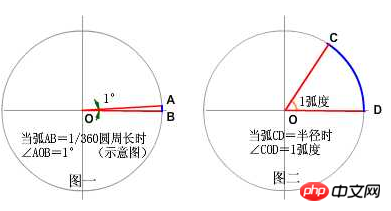
This article mainly shares with you how raphael.js realizes the conversion of angles and radians. It has a good reference value and I hope it will be helpful to everyone. Let’s follow the editor and take a look.
1. Two units of angles
“ Radians ” and “degree” are two different units for measuring angle size. Just like "meter" and "meter" are two different units of measuring length.
It is stipulated in flash that the angle in the rotation angle (rotation) is in "degrees" as the unit; and the angle in the trigonometric function must be in "radians" as the unit. This rule is the first thing we need to remember! ! ! For example: rotation2 - is a rotation of "2 degrees"; sin (π/2) - is the sine of an angle with a size of "π/2 radians".
2. The definition of radian
The so-called "definition of radian" means, how is the angle size of 1 radian defined?
We know that the definition of "degree" is, "Two rays are emitted from the center of the circle to the circumference, forming an included angle and an arc directly opposite the included angle. When the length of this arc is exactly equal to one-360th of the circumference of the circle, The angle between the two rays is 1 degree. (Figure 1)
So, how is the radian defined? The definition of radian is: two rays shoot from the center to the circumference, forming an included angle and an included angle. When the length of this arc is exactly equal to the radius of the circle, the angle between the two rays is 1 radian. (Figure 2)
Compare these two definitions of degrees and radians. Similar. The only difference between them is that the length of the arc subtended by the angle is different. The degree is equal to one-third of the circumference of the circle, while the radian is equal to the radius. Simply put, the definition of radian is that when the angle is When the length of the arc subtended by the angle is equal to the radius, the size of the angle is 1 radian.
Related pictures for this topic are as follows:
## If the length of the arc subtended by the angle is several times the radius, then the size of the angle Just a few radians.  Their relationship can be expressed and calculated by the following formula:
Their relationship can be expressed and calculated by the following formula:
Angle (radians) = arc length/radius
The circumference of a circle is 2π times the radius, so a circumferential angle (360 degrees) is 2π radians.
The length of a semicircle is π times the radius, so a straight angle (180 degrees) is π radians
3. Conversion between degrees and radians
According to the above, a straight angle is π radians. π radians.
That is, 180 degrees = π radians
It can be seen that:
1 degree = π/180 radians (≈0.017453 radians)
Therefore, the formula for converting degrees into radians is obtained:
Radians = Degrees 45×π/180 =π/4 radians
30°=30×π/180 =π/6 radians
120°=120×π/180 =2π/3 radians
In turn, radians become How to calculate degrees?
Because π radians = 180°
So 1 radians = 180°/π (≈57.3°)
Therefore, the formula for converting radians into degrees can be obtained:
Degrees = radians × 180°/π
For example:
4π/3 radians = 4π/3 ×180°/π
= 240°
Maybe some friends will say that it is multiplied by "π/180". Or "180°/π" is easy to get wrong. In fact, you just need to remember: π is π radians, and 180 is 180 degrees. Which unit I want to convert into, I have to put it on the numerator. To convert to radians, place π radians on the numerator - multiply by π/180. In addition, 1 degree is much smaller than 1 radian, only about 0.017453 radians (π/180≈0.017453). Therefore, after converting degrees into radians, the number must become smaller, so when converting into radians, it must be multiplied by π/180. If you can think about it this way, you won't make a mistake.
Write "π" as "PI" in the AS code. And because "π" and "sin" are both "mathematical functions", according to regulations, "Math." must be added in front (Math is the abbreviation of "Mathematics" in English), and then written as "Math.PI", "Math.sin".
So sin30° must be written as Math.sin (30*Math.PI/180). The part in parentheses is to convert 30° into radians, that is, 30×π/180.
/*\
* Raphael.rad
[ method ]
**
* Transform angle to radians
> Parameters
- deg (number) angle in degrees
= (number) angle in radians.
\*/
R.rad = function (deg) { //角度degrees转化成弧度radians
return deg % 360 * PI / 180;
};
/*\
* Raphael.deg
[ method ]
**
* Transform angle to degrees
> Parameters
- rad (number) angle in radians
= (number) angle in degrees.
\*/
R.deg = function (rad) { //弧度radians转化成角度degrees
return Math.round ((rad * 180 / PI% 360)* 1000) / 1000;
};Conversion of radians and angles
Understand the concepts and conversion relationships of angles and radians
The above is the detailed content of How raphael.js implements angle to radian conversion. For more information, please follow other related articles on the PHP Chinese website!




